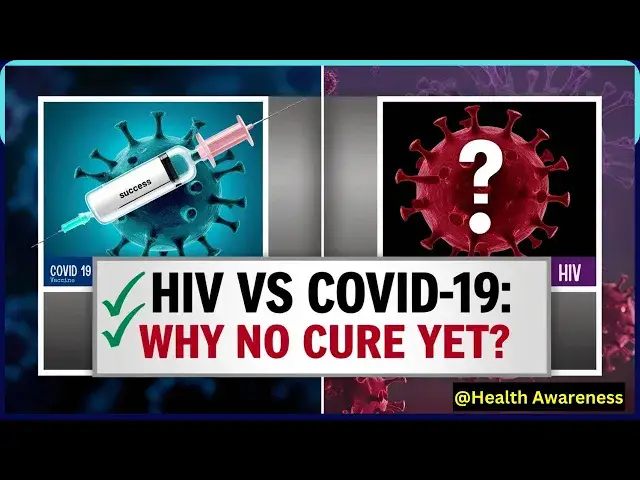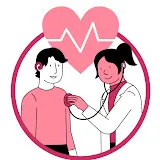0:00
over 40 years since the discovery of HIV
0:02
we still don't have a cure yet for
0:05
covid-19 a virus that emerged just a few
0:07
years ago vaccines were developed and
0:09
rolled out within a year why the
0:11
difference today we're breaking down the
0:14
science the challenges and the progress
0:16
Behind These two very different
0:19
viruses HIV and covid-19 may seem
0:22
similar they're both viruses that have
0:23
impacted millions of lives and driven
0:26
Global Health emergencies but they're
0:28
fundamentally different in how they
0:30
operate how they infect the body and how
0:34
them covid-19 is caused by a Corona
0:37
virus known as SARS K2 it spreads
0:40
primarily through respiratory droplets
0:42
causing respiratory symptoms it's a
0:44
virus that our bodies can typically
0:45
clear given time and a strong immune
0:48
response in contrast HIV is a retrovirus
0:53
it targets the immune system itself
0:55
specifically attacking CD4 cells key
0:57
players in our body's defense system
1:00
the key difference lies in how these
1:02
viruses behave once inside the body HIV
1:05
isn't just a virus that infects and
1:07
moves on it becomes a part of us it
1:09
integrates its genetic material into our
1:12
DNA this is why it's called a retrovirus
1:15
it essentially turns back the clock and
1:17
hides within our cell's genetic code the
1:19
body's immune system can't recognize
1:21
these infected cells as threats because
1:23
they look like any other
1:25
cell covid-19 on the other hand doesn't
1:28
integrate into our DNA a it hijacks our
1:31
cells to make copies of itself but once
1:33
the body recognizes the virus it can
1:35
mount an attack to eliminate it this
1:37
fundamental difference is a huge factor
1:39
in why finding a cure for HIV is so much
1:43
harder another significant difference is
1:45
the mutation rate covid-19 has mutated
1:48
creating variants like Delta and Omron
1:51
but HIV mutates even faster by orders of
1:53
magnitude this makes it incredibly
1:56
adaptable hiv's High mutation rate means
1:59
that it's always one step ahead of our
2:01
immune system and our
2:03
treatments when researchers develop
2:05
drugs or potential vaccines for HIV the
2:08
virus often mutates before the treatment
2:10
can be fully effective it's like trying
2:13
to hit a Target that constantly changes
2:17
appearance many people wonder how we
2:19
developed vaccines for covid-19 so
2:22
quickly the answer lies in timing
2:24
technology and Global collaboration mRNA
2:27
vaccine technology which was used for
2:29
the five and Mna covid-19 vaccines
2:32
wasn't invented overnight it's based on
2:35
Research that had been ongoing for over
2:37
a decade researchers had already been
2:40
exploring mRNA technology for other
2:42
viruses like the flu and even zika when
2:45
covid-19 hit they were able to Pivot
2:47
quickly using the spike protein of the
2:49
Corona virus as the target for the
2:51
vaccine this rapid pivot wouldn't have
2:54
been possible without years of
2:56
groundwork for HIV the focus isn't is n
3:00
just on developing a vaccine it's on
3:01
finding a cure there's a crucial
3:04
distinction while a vaccine primes the
3:06
immune system to prevent infection a
3:08
cure aims to eliminate every last trace
3:10
of the virus from an infected person's
3:12
body given how HIV hides within our DNA
3:18
task even when we use anti-retroviral
3:20
therapy art which can suppress the virus
3:23
to undetectable levels the virus still
3:25
lurks in reservoirs hidden Pockets
3:27
within the body these reservoirs can
3:30
reactivate and start replicating if
3:32
treatment stops which is why lifelong
3:34
medication is currently the
3:37
standard despite the challenges there
3:39
have been significant breakthroughs in
3:42
research we've seen the development of
3:44
long acting injectable medications which
3:46
reduce the need for daily pills and
3:48
scientists are exploring Gene editing
3:50
Technologies like crispr to directly
3:53
Target and remove HIV infected cells the
3:56
Cris PR offers a potential pathway to a
4:00
functional Cure by cutting out the HIV
4:02
DNA integrated into human cells we might
4:05
one day eliminate the virus entirely
4:07
however we're still in the early stages
4:09
of This research and there's much to
4:12
learn the road to a cure for HIV has
4:15
been long and challenging but it's not
4:17
due to a lack of effort or interest HIV
4:20
is one of the most heavily researched
4:22
viruses in history but its unique
4:24
characteristics have made it incredibly
4:27
resilient the good news is that the glob
4:29
Global Response to covid-19 has shown
4:31
what's possible when we mobilize
4:33
resources and prioritize Public Health
4:36
the lessons learned from the co9
4:38
pandemic could help accelerate HIV
4:40
research in ways we haven't seen
4:42
before so while a covid-19 vaccine was
4:45
developed quickly due to its more
4:47
straightforward biology and existing
4:49
research infrastructure HIV remains a
4:51
more complex adversary but progress is
4:54
being made and with new technologies and
4:56
continued research we're closer than
4:58
ever to finding a solution
5:01
if you found this video helpful don't
5:02
forget to like subscribe and hit the
5:04
notification Bell we'll keep you updated
5:06
on the latest in HIV research and other
5:08
health breakthroughs if you have any
5:10
questions or thoughts drop them in the
5:12
comments below we'd love to hear from


